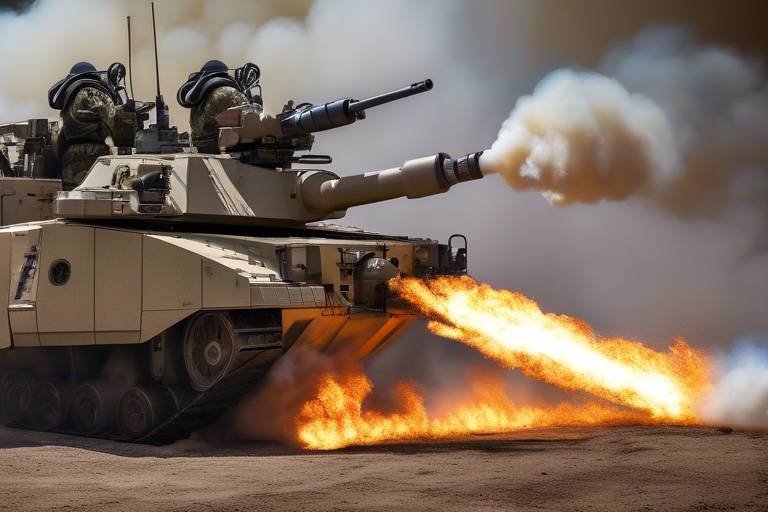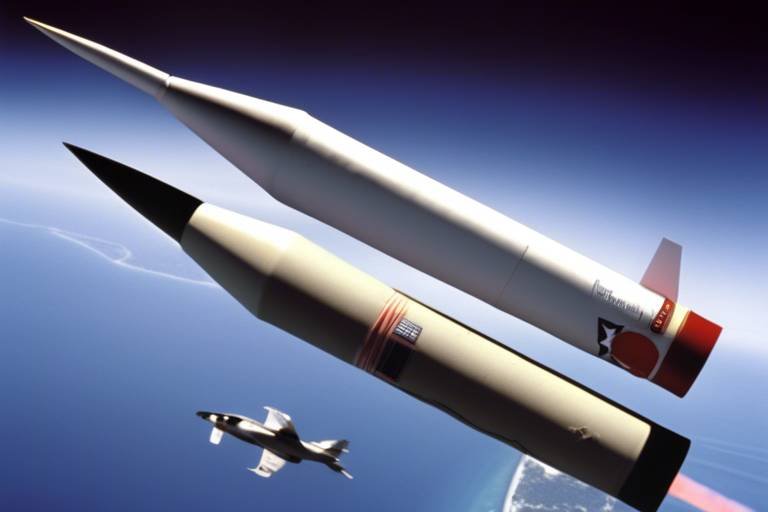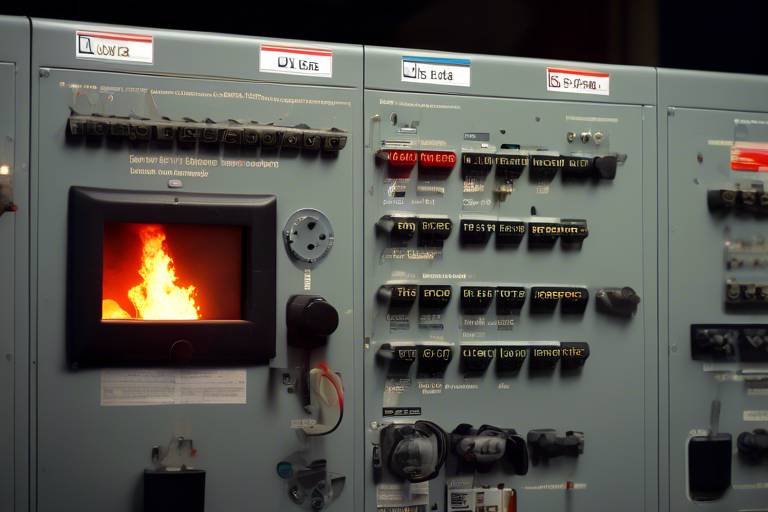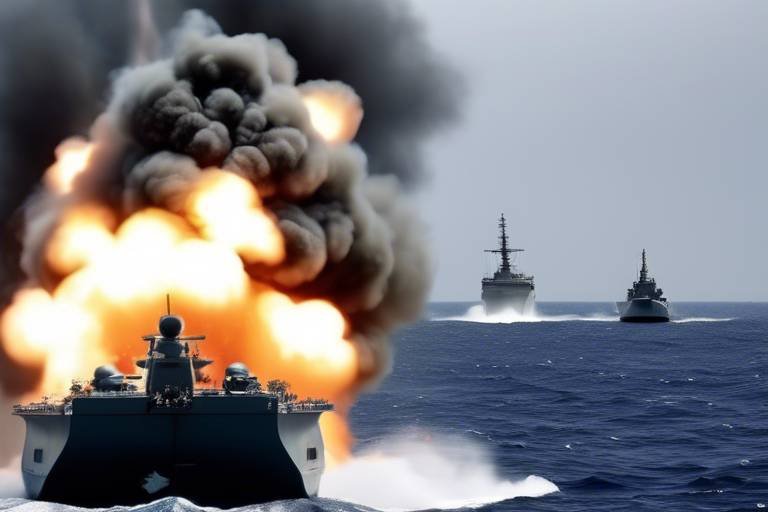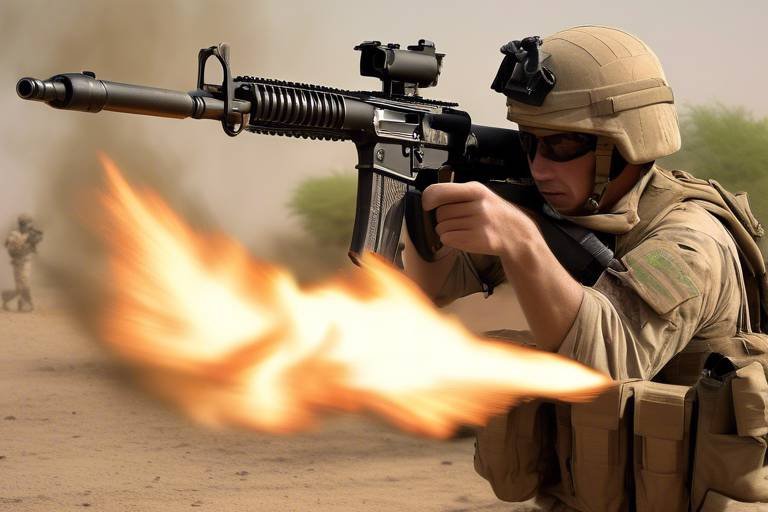How Railguns Are Set to Revolutionize Naval Warfare
In the ever-evolving landscape of military technology, railguns are emerging as a game-changer, poised to redefine naval warfare as we know it. Imagine a weapon that can launch projectiles at speeds exceeding Mach 6 using electromagnetic forces instead of traditional explosives. This revolutionary approach not only enhances the capabilities of naval fleets but also introduces a new era of combat strategy. The implications of railgun technology extend far beyond mere firepower; they challenge conventional wisdom and force military strategists to rethink how they approach engagement at sea.
As we dive deeper into the transformative potential of railguns, it’s crucial to understand the mechanics behind this technology. Unlike traditional artillery, which relies on chemical propellants, railguns utilize powerful electromagnetic fields to accelerate projectiles along two conductive rails. This method results in a projectile that can travel at astonishing speeds, creating a kinetic energy impact that is devastating upon contact. The absence of explosive warheads not only simplifies logistics but also reduces the risks associated with transporting munitions. With railguns, the future of naval warfare looks not just powerful but also efficient.
The advantages of railgun technology are numerous and significant. For instance, the range at which these weapons can engage targets is vastly superior to that of conventional naval guns. This means that naval forces can strike threats from a distance, minimizing their exposure to enemy fire. Furthermore, the cost-effectiveness of railguns cannot be overstated. Traditional munitions can be expensive to produce and maintain, while railgun projectiles are relatively inexpensive, allowing for a more sustainable approach to naval combat. Imagine a future where naval fleets can engage multiple targets without the logistical nightmare of resupplying traditional ammunition. The operational efficiency that railguns offer is truly revolutionary.
However, the road to widespread adoption of railgun technology is not without its challenges. One of the primary hurdles is the need for a reliable power supply. Railguns require significant amounts of energy to operate, which raises questions about their integration with existing naval platforms. Additionally, the engineering challenges in developing robust railgun systems are substantial. Researchers and engineers are tirelessly working to overcome these obstacles, ensuring that railguns can function effectively in the harsh maritime environment.
As we look to the future, it becomes clear that railguns will play a pivotal role in shaping naval warfare strategies. The ability to engage enemies from a distance, coupled with the cost-efficiency of railgun technology, presents a unique opportunity for naval forces worldwide. It’s not just about having a powerful weapon; it’s about rethinking how we approach warfare at sea. The potential for railguns to change the dynamics of naval engagements is enormous, and we are only beginning to scratch the surface of what this technology can achieve.
- What is a railgun? A railgun is a weapon that uses electromagnetic forces to launch projectiles at extremely high speeds, offering advantages over traditional artillery.
- How does a railgun work? Railguns operate by using electric currents to generate magnetic fields that propel projectiles along conductive rails, achieving speeds that can exceed Mach 6.
- What are the advantages of railguns in naval warfare? Railguns provide increased range, precision, cost efficiency, and reduced logistical burdens compared to traditional munitions.
- What challenges do railguns face? Key challenges include the need for a reliable power supply, engineering hurdles, and integration with existing naval systems.
- Will railguns replace traditional naval weapons? While railguns offer significant advantages, they are likely to complement rather than completely replace traditional naval weaponry.
Understanding Railgun Technology
Railgun technology is a fascinating advancement in the realm of military weaponry, leveraging the power of electromagnetic forces to launch projectiles at astonishing speeds. Unlike conventional guns that rely on explosive propellants, railguns utilize electromagnetic energy to accelerate a conductive projectile along two metal rails. This process not only eliminates the need for traditional ammunition but also allows for projectiles to be fired at speeds exceeding Mach 7—that’s over 5,300 miles per hour!
The core principle behind a railgun is quite simple yet revolutionary. When a current is passed through the rails, it generates a magnetic field that propels the projectile forward. This interaction is known as the Lorentz force. The projectile, often made of a dense metal, is pushed out of the barrel with immense force, enabling it to hit targets with incredible kinetic energy. Imagine a bullet that doesn't just pierce but obliterates its target due to sheer speed and mass!
To further understand the mechanics of railgun technology, let’s break it down into its essential components:
- Power Supply: Railguns require a substantial amount of electrical energy, typically sourced from capacitors or power plants. This energy is crucial for generating the electromagnetic forces needed to launch the projectile.
- Launch Mechanism: The design of the railgun's launch mechanism is critical for ensuring the projectile is accelerated efficiently. The use of superconductors and advanced materials is often explored to enhance performance.
- Control Systems: Advanced targeting and control systems are essential to accurately aim and fire the railgun. These systems rely on sophisticated algorithms and sensors to calculate the trajectory and adjust for environmental factors.
One of the most exciting aspects of railgun technology is its potential application in naval warfare. With the ability to fire projectiles at extreme velocities, railguns can engage targets at significantly greater distances than traditional naval artillery. This capability not only enhances a navy's striking power but also provides a tactical advantage by allowing forces to engage threats before they can retaliate.
Moreover, the projectile's high speed results in a flat trajectory, making it harder for enemy defenses to intercept. Unlike conventional munitions that follow a parabolic path, railgun projectiles can maintain a direct line of sight to their target, enhancing accuracy and effectiveness in combat scenarios.
As we delve deeper into the operational capabilities of railguns, it becomes clear that this technology is not just a novelty—it's a game changer. The implications for future military strategies are profound. With ongoing research and development, railgun technology is poised to redefine how naval forces conduct warfare, offering a glimpse into a future where speed and precision dominate the battlefield.
Advantages of Railguns in Naval Combat
The advent of railgun technology heralds a new era in naval warfare, providing advantages that could shift the balance of power at sea. One of the most compelling benefits is the **increased range** and **precision** that railguns offer. Traditional naval artillery systems are often limited by their range and the speed at which they can engage targets. In contrast, railguns can launch projectiles at velocities exceeding **Mach 6**, allowing them to strike targets at distances previously thought unattainable. This capability not only enhances the effectiveness of naval forces but also provides a strategic advantage by keeping adversaries at bay.
Imagine a naval fleet that can engage enemy vessels or aerial threats from hundreds of miles away, striking swiftly and accurately before the enemy can even react. This **tactical superiority** is a game-changer. The ability to engage targets at such distances means that naval forces can operate in a more offensive posture, potentially neutralizing threats before they can launch their own attacks. Furthermore, the **precision** of railgun projectiles minimizes collateral damage, a crucial consideration in modern warfare where civilian lives and infrastructure must be protected.
Another significant advantage of railguns is their **cost efficiency**. Unlike traditional munitions, which can be expensive to produce and maintain, railgun projectiles are relatively inexpensive. The cost savings come not only from the reduced price of the projectiles themselves but also from the lower logistical burden associated with transporting and storing conventional ammunition. This means naval fleets can maintain a more sustainable operational tempo without the constant need to replenish costly munitions.
Furthermore, railguns require less maintenance than traditional systems, as they do not rely on explosive propellants. This reduction in maintenance needs translates to more time spent on operational readiness and less time in dry dock for repairs. The **sustainability** of railgun systems is also noteworthy; as they rely on electrical energy rather than chemical reactions, they can be integrated into existing naval platforms with relative ease, provided the necessary power supply is available. This integration can streamline operations and enhance overall fleet efficiency.
In summary, the advantages of railguns in naval combat are multifaceted. They provide increased range and precision, cost efficiency, and sustainability, all of which contribute to a more formidable naval force. As we look toward the future of naval warfare, the integration of railgun technology could very well redefine how naval engagements are conducted. The strategic landscape is evolving, and those who adapt to these changes will undoubtedly have the upper hand in maritime conflicts.
- What is a railgun? A railgun is a type of weapon that uses electromagnetic forces to launch projectiles at extremely high speeds, significantly faster than traditional firearms.
- How does a railgun work? Railguns operate by passing a strong electric current through two conductive rails, creating a magnetic field that propels a projectile along the rails and out of the barrel.
- What are the benefits of using railguns in naval warfare? Railguns offer increased range, precision, cost efficiency, and sustainability compared to traditional naval weaponry.
- Are there any challenges associated with railgun technology? Yes, challenges include technological hurdles related to power supply, engineering complexities, and the integration of railguns into existing naval platforms.
Increased Range and Precision
One of the most significant benefits of railguns is their ability to engage targets at greater distances with high precision. Imagine a traditional naval cannon that can only reach a limited range, often requiring ships to get dangerously close to enemy vessels. In contrast, railguns can fire projectiles at speeds exceeding Mach 6, which translates to a range of over 100 nautical miles. This incredible reach allows naval forces to strike from a safe distance, keeping them out of harm's way while still delivering devastating firepower.
But how does this enhanced range translate into practical advantages during naval operations? For starters, the increased engagement distance means that naval ships can neutralize threats before they even realize they're under attack. This capability could be a game-changer in scenarios involving missile threats or hostile ships, allowing for proactive defense strategies. Think of it as having a long-range sniper rifle instead of a shotgun; the sniper can pick off targets from a distance without exposing themselves to return fire.
Moreover, the precision of railgun projectiles is bolstered by advanced targeting systems. These systems utilize sophisticated sensors and tracking technologies to lock onto targets with remarkable accuracy. When combined with the railgun's speed and range, this precision ensures that naval forces can effectively engage enemy assets while minimizing collateral damage. In essence, railguns transform naval engagements into a high-stakes game of chess, where each move is calculated and executed with deadly efficiency.
To illustrate the potential impact of increased range and precision, consider the following table that compares traditional naval artillery with railgun technology:
| Feature | Traditional Naval Artillery | Railgun Technology |
|---|---|---|
| Maximum Range | Approximately 20 nautical miles | Over 100 nautical miles |
| Projectile Speed | Up to Mach 2 | Exceeds Mach 6 |
| Targeting Accuracy | Moderate | High |
| Reload Time | Minutes | Seconds |
This table highlights the stark differences between traditional artillery and railgun technology. The ability to strike targets from a significant distance not only enhances the safety of naval vessels but also allows for greater tactical flexibility. With railguns, commanders can dictate the pace of engagements, choosing when and how to engage the enemy, which is crucial in modern naval warfare.
In conclusion, the increased range and precision offered by railguns represent a monumental shift in naval combat strategies. As this technology continues to evolve, we can expect to see a transformation in how naval forces operate, making engagements more strategic and less reliant on close-quarter battles. The future of naval warfare is undoubtedly exciting, and railguns are at the forefront of this revolution.
Impact on Target Engagement
The introduction of railgun technology into naval warfare is akin to upgrading from a horse-drawn carriage to a high-speed train; the difference in capability is monumental. With their ability to launch projectiles at velocities exceeding Mach 6, railguns empower naval forces to engage enemy targets from unprecedented distances. This capability not only enhances the strategic positioning of naval vessels but also fundamentally alters the dynamics of naval engagements. Imagine being able to strike an adversary before they even have the chance to respond—this is the new reality that railguns bring to the battlefield.
In practical terms, the extended range of railguns means that naval forces can operate in a more defensive posture, allowing them to engage threats while remaining beyond the effective range of traditional weaponry. This shift is crucial when considering modern warfare, where threats can emerge rapidly, and the element of surprise can dictate the outcome of engagements. The ability to strike first is a game-changer, and railguns provide that upper hand.
Moreover, the integration of advanced targeting systems with railgun technology enhances the accuracy of these long-range strikes. These systems leverage a combination of radar, sensors, and artificial intelligence to ensure that each shot is not just a shot in the dark but a calculated move with a high probability of hitting the intended target. For instance, the use of predictive algorithms allows naval commanders to assess variables such as wind speed, projectile drop, and target movement in real-time, making adjustments on the fly. This level of precision can be the difference between a successful strike and a costly miss.
To illustrate the impact of railguns on target engagement, consider the following table that compares traditional naval artillery with railgun capabilities:
| Feature | Traditional Naval Artillery | Railgun Technology |
|---|---|---|
| Projectile Speed | Up to 1,000 m/s | Exceeds 2,000 m/s |
| Effective Range | Up to 20 km | Over 100 km |
| Reload Time | Minutes | Seconds |
| Ammunition Cost | High | Significantly Lower |
This table highlights not just the superiority of railguns in terms of speed and range, but also their operational efficiency. The ability to fire multiple projectiles in quick succession without the logistical burden of traditional ammunition can significantly enhance a naval fleet's combat effectiveness.
In conclusion, the impact of railgun technology on target engagement is profound. By enabling naval forces to strike from long distances with pinpoint accuracy, railguns not only enhance defensive capabilities but also redefine the very nature of naval warfare. As this technology matures, we can expect to see a shift in military strategies that prioritize long-range engagements and rapid response times, fundamentally changing how naval battles are fought.
- What is a railgun? A railgun is a type of weapon that uses electromagnetic forces to launch projectiles at extremely high speeds.
- How does a railgun differ from traditional naval artillery? Railguns can achieve much higher projectile speeds and ranges, and they have lower operational costs compared to traditional artillery.
- What are the challenges of implementing railgun technology? Challenges include technological hurdles, power supply issues, and the integration of railguns with existing naval platforms.
- What are the implications of railgun technology for future naval warfare? Railguns may change military strategies by prioritizing long-range engagements and enhancing defensive capabilities.
Accuracy and Targeting Systems
When it comes to naval warfare, precision is not just a luxury; it’s a necessity. The accuracy of railguns is significantly enhanced through advanced targeting systems that integrate cutting-edge technology. Imagine a sniper with the best rifle and the clearest scope; that’s the kind of precision railguns can achieve. These systems utilize a combination of sensors, software, and algorithms to calculate the trajectory and speed of the projectile, ensuring that it hits its intended target with astonishing accuracy.
The heart of these targeting systems lies in their ability to process vast amounts of data in real-time. Utilizing radar, infrared, and optical sensors, the systems can track multiple targets simultaneously, even in challenging environments. This capability is akin to having a hawk's eye, allowing naval forces to engage threats with pinpoint precision from distances previously thought impossible. As a result, the risk of collateral damage is minimized, making railguns not only more effective but also more responsible in combat scenarios.
Moreover, the integration of artificial intelligence (AI) into these systems enhances decision-making processes. AI algorithms can analyze data faster than any human operator, predicting the movement of targets and adjusting the firing parameters accordingly. This means that naval forces can respond to threats more swiftly and accurately, effectively turning the tide of battle in their favor. The synergy between AI and railgun technology is set to redefine naval engagements, making them more dynamic and strategically complex.
To illustrate the advancements in accuracy and targeting systems, consider the following table that outlines the key features:
| Feature | Description |
|---|---|
| Real-time Data Processing | Utilizes advanced algorithms to analyze data from multiple sensors instantaneously. |
| Multi-target Tracking | Capable of engaging several targets at once, improving tactical flexibility. |
| AI Integration | Enhances decision-making by predicting target movements and optimizing firing solutions. |
| Reduced Collateral Damage | Increased precision minimizes the risk of unintended damage to surrounding areas. |
In conclusion, the accuracy and targeting systems associated with railgun technology represent a quantum leap forward in naval warfare. With the ability to engage targets at unprecedented ranges and with remarkable precision, railguns could very well become the cornerstone of future naval combat strategies. As military forces continue to invest in these technologies, the implications for global naval power dynamics will be profound, ushering in a new era of warfare that emphasizes speed, precision, and technological superiority.
- What is a railgun? A railgun is a weapon that uses electromagnetic forces to launch projectiles at high speeds, offering advantages over traditional firearms.
- How accurate are railguns? Railguns are designed to be highly accurate, thanks to advanced targeting systems that utilize real-time data processing and AI technology.
- What are the main advantages of railguns in naval warfare? The main advantages include increased range, reduced ammunition costs, and enhanced precision, which can change the landscape of naval engagements.
- Are there any challenges associated with railgun technology? Yes, challenges include technological hurdles, operational limitations, and the need for significant power supply integration.
Cost Efficiency and Sustainability
When it comes to modern warfare, the financial implications of military technology can be staggering. Traditional naval munitions, such as missiles and torpedoes, often come with hefty price tags, not to mention the costs associated with their logistics and storage. Enter the railgun, a game-changer in terms of both cost efficiency and sustainability. Imagine being able to fire projectiles at a fraction of the cost of conventional weapons while also reducing the environmental footprint of naval operations. Sounds too good to be true? Let’s dive deeper.
One of the most compelling advantages of railgun technology lies in its operational costs. Unlike traditional munitions, which require complex manufacturing processes and expensive materials, railgun projectiles are made from simple conductive materials. This can significantly lower production costs, allowing naval forces to stockpile munitions without breaking the bank. For instance, while a single missile might cost hundreds of thousands of dollars, a railgun round can be produced for a mere fraction of that price. The table below illustrates this cost comparison:
| Type of Munition | Average Cost per Round |
|---|---|
| Conventional Missile | $500,000+ |
| Railgun Projectile | $25,000 |
In addition to lower production costs, railguns also offer sustainability benefits. By utilizing electromagnetic forces instead of explosive propellants, railguns minimize the risk of environmental contamination. Traditional munitions can leave behind hazardous waste and contribute to pollution, whereas railgun projectiles, being non-explosive, have a much smaller ecological impact. This aspect is particularly important in today’s world, where military operations are increasingly scrutinized for their environmental effects.
Moreover, the logistics of supplying traditional munitions can be a logistical nightmare. Transporting heavy and sensitive explosives requires strict safety measures and considerable resources. Railgun systems, however, simplify this process. With less reliance on bulky munitions, naval fleets can reduce their logistical burden, allowing for more efficient use of resources. Imagine a fleet that can focus more on mission readiness and less on the complexities of ammunition supply. This shift not only boosts operational efficiency but also enhances overall naval readiness.
In summary, the adoption of railgun technology could lead to a revolutionary shift in naval warfare, characterized by lower costs and a more sustainable approach to military operations. As nations continue to invest in advanced technologies, the railgun stands out as a beacon of efficiency and environmental responsibility. The future of naval warfare might just be a lot greener – and a lot more cost-effective – thanks to this innovative technology.
- What is a railgun? A railgun is a weapon that uses electromagnetic forces to launch projectiles at extremely high speeds, offering advantages over traditional firearms.
- How does a railgun differ from conventional weapons? Railguns do not rely on explosive propellants, making them cheaper to produce and operate while also being more environmentally friendly.
- What are the main advantages of using railguns in naval warfare? Railguns offer increased range, precision, cost efficiency, and reduced logistical burdens compared to traditional munitions.
- Are there any challenges associated with railgun technology? Yes, railguns face technological hurdles and operational limitations, including power supply issues and integration with existing naval platforms.
Challenges and Limitations
While railgun technology holds immense promise for reshaping naval warfare, it is not without its . As we dive into this topic, it's crucial to understand that innovation often comes with hurdles that must be navigated before widespread adoption can occur. One of the primary challenges is the technological hurdles associated with developing a reliable and effective railgun system. These systems require advanced engineering solutions to manage the immense forces generated during operation. The electromagnetic forces needed to launch projectiles at hypersonic speeds demand materials that can withstand extreme conditions, which is not a trivial feat.
Moreover, the need for a robust power supply complicates matters further. Railguns consume a significant amount of energy, and integrating them into existing naval platforms poses logistical challenges. Current naval vessels may need substantial upgrades to accommodate the power requirements of railguns, which can be both costly and time-consuming. This requirement for enhanced power systems can limit the number of ships that can effectively deploy railgun technology.
Another limitation lies in the operational constraints that affect railgun deployment. For instance, while railguns can deliver projectiles at incredible speeds, the effectiveness of these weapons in real-world combat scenarios is still being evaluated. The accuracy of railgun fire can be influenced by several factors, including environmental conditions and the speed of the target. Additionally, the integration of advanced targeting systems is essential to maximize the potential of railguns, and developing these systems is an ongoing challenge.
To illustrate these challenges more clearly, consider the following table that outlines some of the key obstacles facing railgun technology:
| Challenge | Description |
|---|---|
| Technological Hurdles | Engineering challenges related to materials and design for high-speed projectile launch. |
| Power Supply | High energy consumption requires significant upgrades to existing naval vessels. |
| Operational Constraints | Factors affecting accuracy and effectiveness in real-world combat scenarios. |
Despite these challenges, research and development efforts are underway to address these limitations. Military organizations are investing in advanced materials and energy solutions to enhance the feasibility of railguns in naval operations. As technology progresses, it is likely that many of the current barriers will be overcome, paving the way for railguns to become a standard component of naval arsenals.
In conclusion, while railgun technology presents exciting possibilities for the future of naval warfare, it is essential to recognize the challenges that lie ahead. Overcoming these obstacles will require innovation, investment, and a commitment to advancing military technology. The journey may be fraught with difficulties, but the potential rewards in terms of enhanced naval capabilities are worth the effort.
1. What is a railgun?
A railgun is a type of weapon that uses electromagnetic forces to launch projectiles at extremely high speeds, offering advantages over traditional gunpowder-based artillery.
2. What are the main advantages of railguns?
Railguns offer increased range, higher precision, and reduced ammunition costs compared to conventional naval weaponry.
3. What challenges do railguns face?
Railguns face several challenges, including technological hurdles, power supply requirements, and operational limitations that affect their deployment and effectiveness.
4. How are militaries addressing the challenges of railgun technology?
Military organizations are investing in research and development to create advanced materials and energy solutions that can support the effective use of railguns in naval operations.
Technological Hurdles
As promising as railgun technology is, it does not come without its share of . Developing a reliable railgun system is akin to trying to build a high-speed train on a shaky bridge; the engineering challenges are significant and multifaceted. One of the primary obstacles lies in the power supply. Railguns require immense amounts of electrical energy to function effectively, and generating this power on a naval vessel poses serious challenges. Current systems often struggle to provide the necessary energy output while maintaining operational efficiency. This means that naval fleets must invest in advanced energy storage solutions or alternative power generation methods to support railgun operations.
Furthermore, the materials used in railgun construction must withstand extreme conditions. The projectiles are launched at speeds that can exceed Mach 6, generating tremendous heat and stress on the railgun's components. This leads to rapid wear and tear, necessitating frequent maintenance and replacement of parts, which can be a logistical nightmare. Engineers are continuously exploring new materials and designs to enhance durability and reduce maintenance requirements, but progress is slow.
Another critical aspect is the guidance and targeting systems. While railguns can theoretically achieve high precision, the integration of advanced targeting technologies is essential to realize this potential. Traditional naval targeting systems may not be compatible with the unique characteristics of railgun projectiles, necessitating the development of new algorithms and systems. This is not just a matter of enhancing accuracy; it’s about ensuring that naval forces can make quick, informed decisions in the heat of battle.
Moreover, the integration challenge with existing naval platforms cannot be overlooked. Railguns are fundamentally different from conventional artillery systems, and retrofitting current ships to accommodate them requires extensive modifications. This can lead to increased costs and extended timelines for deployment. The U.S. Navy and other naval forces are currently evaluating how best to incorporate railgun technology into their fleets while balancing the need for modernization with budgetary constraints.
In conclusion, while the potential of railguns in naval warfare is exciting, the path to widespread adoption is fraught with challenges. Addressing these technological hurdles will require a concerted effort from engineers, military strategists, and policymakers alike. As research continues, the hope is that innovative solutions will emerge, paving the way for railguns to become a mainstay in modern naval arsenals.
- What is a railgun? A railgun is a weapon that uses electromagnetic forces to launch projectiles at extremely high speeds, providing a significant advantage over traditional artillery.
- How do railguns differ from conventional weapons? Unlike conventional weapons that rely on chemical propellants, railguns use electrical energy to propel projectiles, which can lead to greater range and accuracy.
- What are the main challenges facing railgun technology? Key challenges include power supply issues, material durability, integration with existing naval systems, and the development of advanced targeting systems.
- Are railguns currently in use by naval forces? While railgun technology is still in development and testing stages, some navies are actively exploring its potential for future deployment.
Operational Limitations
While railguns present a thrilling leap forward in naval warfare technology, they are not without their . One of the most pressing challenges is the need for a robust power supply. Railguns operate using immense amounts of electricity to generate the electromagnetic forces required to launch projectiles at hypersonic speeds. This means that ships equipped with railguns must have enhanced power generation capabilities, which can complicate design and increase costs. Imagine trying to power a high-speed train with the electricity of a household outlet—it's simply not feasible!
Furthermore, integrating railgun systems into existing naval platforms poses another hurdle. Many current ships were not designed to accommodate the size and weight of railguns, nor the sophisticated power systems they require. This could necessitate extensive retrofitting or the construction of entirely new classes of vessels, which is both time-consuming and expensive. The U.S. Navy, for example, has been exploring various options but has yet to finalize a design that effectively incorporates railgun technology without compromising other operational capabilities.
In addition to power and integration issues, there are also logistical challenges related to the ammunition used by railguns. Unlike traditional munitions, which can be stockpiled and stored relatively easily, the projectiles for railguns are designed for high-performance and require specific materials and manufacturing processes. This could lead to supply chain complexities and increased costs. Moreover, the need for specialized training for personnel to operate and maintain these systems adds another layer of operational complexity.
To summarize, while railguns offer exciting possibilities for naval warfare, their operational limitations must be carefully considered. The challenges of power supply, integration with existing platforms, and logistical requirements are significant. As military forces continue to explore the potential of this technology, overcoming these hurdles will be essential for the successful deployment of railguns in real-world scenarios. The journey toward fully operational railgun systems is akin to navigating through a storm—there are many obstacles to overcome before reaching the calm waters of effective implementation.
- What is a railgun? A railgun is an electromagnetic weapon that uses electric currents to launch projectiles at extremely high speeds.
- How does a railgun differ from traditional naval weapons? Unlike traditional weapons that rely on explosive propellants, railguns utilize electromagnetic forces, allowing for greater range and speed.
- What are the main challenges facing railgun technology? Key challenges include the need for a robust power supply, integration with existing naval platforms, and logistical issues related to ammunition supply.
- Are railguns currently in use by any military? As of now, railguns are primarily in the experimental phase, with various militaries conducting tests and research.
Frequently Asked Questions
- What is a railgun?
A railgun is a type of weapon that uses electromagnetic forces to launch projectiles at extremely high speeds. Unlike traditional guns that rely on explosive propellants, railguns utilize powerful electric currents to accelerate projectiles along conductive rails, resulting in greater velocity and range.
- How do railguns enhance naval combat?
Railguns significantly improve naval combat by providing increased range and precision. They enable naval forces to engage targets from greater distances, minimizing the risk of retaliation. This capability allows for strategic advantages in military operations, making railguns a game-changer in naval warfare.
- What are the cost benefits of using railguns?
Railguns offer notable cost advantages over traditional munitions. They require less expensive ammunition, which is primarily composed of metal projectiles rather than costly explosives. Additionally, the reduced logistical burden associated with transporting and storing ammunition makes railguns a more sustainable option for naval fleets.
- What challenges do railguns face?
Despite their potential, railguns encounter several challenges, including technological hurdles like energy supply and materials that can withstand extreme conditions. Operational limitations also exist, as integrating railguns with existing naval platforms requires significant engineering and design adjustments.
- How accurate are railguns?
Railguns are designed to achieve high levels of accuracy through advanced targeting systems. These systems incorporate sophisticated technology that enhances targeting capabilities, allowing naval forces to hit precise targets even at extended ranges, which is crucial in combat scenarios.
- Are railguns currently in use?
As of now, railgun technology is still in the experimental and developmental stages. While some prototypes have been tested, widespread operational deployment in naval fleets has not yet occurred. Ongoing research and development efforts aim to overcome existing challenges and bring railguns into active service.




